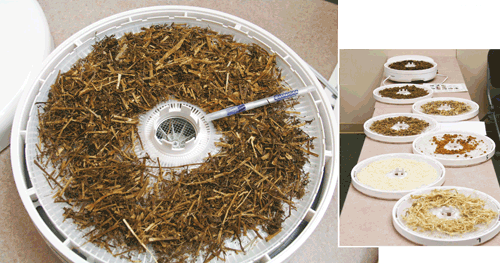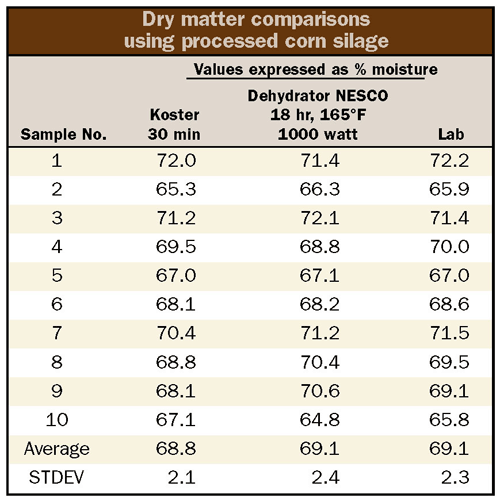How Long to Bake Feed to Determine Dry Matter
The author is a dairy agent with the University of Wisconsin-Extension in Fond du Lac County, Wis.

by using the 10-tray dehydrator that we purchased.
A cow is an amazing creature. She is a fine-tuned production system. She is a fermentation vat with a tongue, a tail, and four legs.
The biggest stumbling block to delivering a consistent feed to cows is monitoring the dry matter in feedstuffs. Feedstuffs such as high-moisture corn and a wide variety of wet by-products can vary greatly in their dry matter content. It is critical for nutritionists to work with producers and employees to develop a simple and repeatable method for monitoring and adjusting for dry matter changes.
Simple implies that the dairy producer or employee can monitor the dry matter and not make mistakes doing it. Simple also implies that it is easy to do.
Repeatable means that you know the results will be same if you redid the same procedure. Test the current system for determining dry matter on the farm. If a producer or employee does not end up with the same dry matter after repeating the same procedure three or four times, the dry matter check system isn't working.
The three parts to determining and adjusting for dry matter on farms include: a) proper sampling, b) proper testing procedures, c) proper TMR adjustment.
If you are not going to properly sample a feedstuff, then just save time and buy a good dartboard. It's likely to be nearly as accurate.
For bunkers, sampling by taking grab samples from the face is both dangerous and useless. If you repeat this four times on the same day, you are likely to get four different results. Take a bunker facer (or bucket) and remove the feedstuff from the entire face. Mix this in a TMR mixer for a few minutes and then sample the feedstuff. This may seem labor intensive. However, a proper sampling technique will actually save you time if you can sample less often (maybe every three days instead of daily). Bunkers are usually filled in a layered, wedge fashion. This same layering that makes grab samples useless will make a feedstuff from a bunker relatively consistent when removed evenly.
For top unloading tower silos, sample periodically until the unloader completes an entire revolution. Sample the feedstuff. Simple. For bottom unloading silos, sample during unloading over an entire feeding.
Feedstuffs (especially forages) stored in plastic bags are perhaps the most difficult to manage for dry matter. This is perhaps the biggest drawback of bags and should be a factor when deciding on a storage type. As a bag is filled, each load creates a vertical slice (especially on smaller bags). This can lead to dramatic changes in dry matter every day. Mixing all the forage from a bag before it is fed is likely the best recommendation but not the simplest. Work with your nutritionist to develop a sampling technique for your situation.
Ok, you got a perfect sample. Now what? How should we test it? Let's look at the options:
a) Lab. Sending the sample to the lab eliminates on-farm error. There is no worry that an employee just guessed instead of measured. And it's simple. Pop it in the mail or give it to the nutritionist. There are some challenges. Results will likely not be available for a couple days, you may not be able to justify the expense of sending samples to the lab, and labs are not open on weekends.
b) Microwave. In less than 10 minutes, you can have a dry matter result with a microwave. It is relatively cheap. But does it pass the simple and repeatable test? Are you willing to watch the sample like a hawk? Are your employees precise, and do they like math?
c) Koster Crop Tester. They are tried and true. In about 30 minutes, you can have the dry matter of forage sample at a reasonable cost. This is perhaps the most widely accepted method of testing. But there are some concerns. You need to watch the sample closely. Running the sample too long will result in inaccurate numbers; running it too short will also lead to errors. Kosters can be fire hazards if placed near flammable material (found in most feed rooms).

If you have more than one sample, you need more than one Koster or more time. Determining dry matter for fine ingredients like wet distillers and high-moisture ground corn does not work because of screen sizes. Finally, the little scale that comes with the Koster does not last very long and can be difficult to work with. Scrap the little scale soon after its arrival and use a gram scale.
d) Food Dehydrator. Although not widely used on farms, a food dehydrator might meet the simple and repeatable test on many farms. When purchased with the "fruit roll up" trays, dehydrators can handle fine ingredients like rolled high-moisture corn and wet distillers. It's reasonably priced at around $100. Multiple trays allow the user to dry down anywhere from 1 to 30 ingredients at once. The dehydrator also gives flexibility in drying time. The normal drying time for dehydrators will be 8 to 12 hours. A nice feature is that you can leave them for a few extra hours and still have an accurate result. (After 8 hours, the dry matter simply plateaus.) You could put the samples in at 5 p.m., and by the next morning (5 to 9 a.m.), the samples will be ready.
Will the dehydrator really work? Here at the extension office, we bought a dehydrator to compare it to the Koster and lab results. We bought a NESCO Gardenmaster 1000 watt with 165°F thermostat. We bought the fruit roll up trays to lay our samples on and six additional trays (for a total of 10 trays). The total cost was about $130; we used a gram scale we had in the office.
We determined dry matter for 10 samples of processed corn silage by three methods: Koster, dehydrator, and lab. The results among all three methods were relatively consistent; the average for the dehydrator and lab dry matters were identical. The dehydrator could be used by many farms that have multiple samples, can let samples run overnight, or are concerned about safety, accuracy, and expense of other methods. Previous experience has shown that corn silage with whole kernels might not dry down properly with a Dehydrator or Koster Tester.
Proper TMR adjustment
After a dry matter is determined on a feedstuff, what do you do with it? Is the TMR computer and/or scale adjusted? Is there a mixing sheet that includes dry matter adjustments? Does the producer or employee adjust the amount of feedstuff fed? Again, simple and repeatable. Make sure you know who is responsible and record all changes.
100310_171
Source: https://hoards.com/article-1863-monitoring-feed-dry-matter-keep-it-simple-and-repeatable.html
0 Response to "How Long to Bake Feed to Determine Dry Matter"
Post a Comment